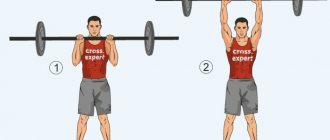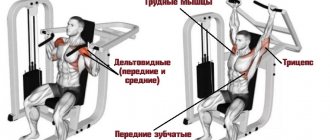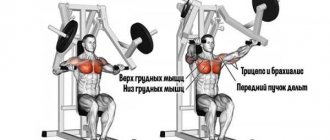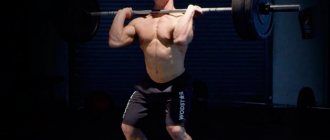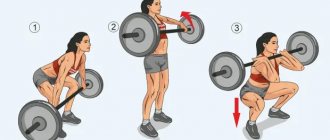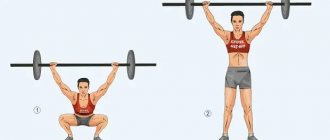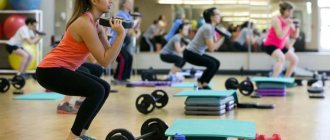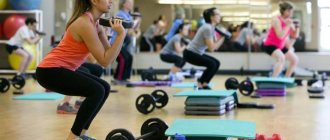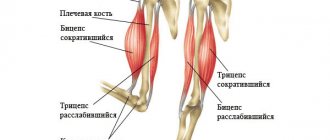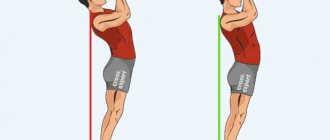Publication date: December 24, 2022.
Broad shoulders adorn both male and female figures. For guys, they are, first of all, an indicator of strength and masculinity, and girls like the fact that, thanks to wide shoulders, the waist seems narrower.
Conventionally, the shoulders can be divided into two hemispheres - front and back. The latter works when performing traction movements, that is, in those cases when you bring the weight closer to you.
The anterior hemisphere, accordingly, is used primarily when pushing the load away from the body.
This is exactly the movement that occurs when performing a seated chest press. Let's look at it in more detail.
What muscles work
The seated barbell press is one of the main exercises for working the deltoids. When performing this press, the following are involved:
- deltoid muscles;
- trapezoid;
- pectoral muscles;
- triceps.
Another advantage of this exercise, along with good shoulder training, is that it allows you to load the upper chest.
Since the upper part of the pectoral muscles lags behind in almost everyone, any exercise that gives the opportunity to work it will not be out of place in the training program.
The front deltas receive the largest part of the load during a vertical chest press; the lateral deltas are included in the work much less. In this case, you can additionally transfer part of the load from the anterior bundles of deltoid muscles to the lateral ones by varying the grip width.
Why press overhead
The primary goal of the exercise is to pump up the deltoids, upper back and triceps brachii muscles. It is believed that the exercise is one of the best for their development.
The bench press works not only the target muscle groups. The abdominal wall and pelvic area are also strengthened here. In addition, the legs are included as stabilizers.
However, before adding it to your training program, you need to sort everything out in terms of technique.
The overhead press looks easy—just lift the barbell up and exhale. But there are many nuances that affect efficiency.
Execution options
Seated chest press
The main thing for this exercise is to place your hands on the bar slightly wider than your shoulders. However, depending on the individual anatomy, as well as the goals and objectives of performing the bench press, it can be slightly changed.
With a narrow grip, the front deltas work to the maximum. Wide, accordingly, allows you to transfer a significant part of the load to the side buns - it is perfect if your goal is wide shoulders.
Overhead press
This embodiment allows you to exclude the chest from work as much as possible, transferring almost the entire load to the deltoids.
At the same time, the lateral and even posterior bundles of the deltoid muscles, which are weakly involved when pressing the barbell from the chest, are more actively involved in the work.
Bent-over barbell press
This option involves performing bench presses while sitting on an incline bench. This technique allows you to give maximum load to the pectoral muscles. The required backrest angle is 30-45 degrees.
Shoulder anatomy
The shoulder muscle is otherwise called the “delta” for its similarity to the triangular shape of the Latin letter of the same name. The biceps and triceps are located lower and do not belong to the deltoid muscle. Therefore, an athlete doing shoulder exercises must understand that as a result, only his upper arms will be pumped up, but not his arms themselves. It is for this reason that delt exercises are suitable for girls who want to have relatively broad shoulders, but do not want to be too muscular.
The deltoid muscle is attached to three bones: the humerus, scapula and clavicle. When performing exercises, take into account the individual characteristics of the body. If you have had fractures or dislocations of the listed bones, it is recommended to exercise only with a trainer, and loads should be limited. A similar requirement applies to injuries of the shoulder joints or their ligaments.
The delta consists of three bundles: anterior, middle (lateral) and posterior.
The two main functions of the delta are to push the load away from you and to pull it towards you. These two components give rise to all the variety of movements that we use in shoulder exercises. When we do front swings, dumbbell and barbell presses, we develop the pushing function (front beam). Swings from the sides or in an inclined position, as well as all kinds of traction, are the second component (middle and rear beams).
For the full development of deltas, you need to perform at least one exercise for each of the beams. Most often, athletes “fall out” of the back and middle ones, since the front one is quite easy to pump up thanks to its participation in all presses, and exercises for the other two beams are either neglected, or not done enough, or with the wrong technique (for example, swinging heavy dumbbells with cheating) .
Execution technique
Let's look at the technique of performing a seated chest press. Options for performing the exercise, which involve lifting the barbell from behind the head or in a tilted position, essentially differ only in the position of the arms and body.
- Take the barbell from the racks and take the starting position: sit on the bench with your legs wide apart and your feet firmly planted on the floor, the bar of the barbell is at your upper chest, your back and forearms are vertical, your chest and shoulders are straightened, your gaze is directed in front of you.
- As you exhale, quickly but smoothly straighten your arms, lifting the barbell up
- While inhaling, slowly, maintaining control over the apparatus and maintaining the correct trajectory of movement, lower the barbell down.
Don't forget that your joints should be well warmed up before starting the exercise. This will reduce the risk of injury to a minimum.
Particular attention must be paid to the shoulder joints, which, when performing a seated barbell press, receive a rather atypical load for them.
As for the negative phase of the movement: spend two to three times more time lowering the weight than lifting it - in this case, your muscles will grow at the fastest pace.
During this exercise, the barbell moves over a wide amplitude, therefore, if you want to increase muscle size and mass, you need to do from 6 to 12 (maximum 15) repetitions in one approach.
The exception is the overhead press: in this case, in order not to injure the shoulder joints, it is better to use less weight, doing 15 to 20 repetitions.
Use a bench with a backrest to provide good support for your core during the exercise. This will avoid a lot of stress on the spine, and will also help you concentrate on high-quality work of the target muscles.
Even if you do not have back problems, it is always better to choose between two exercise options - standing and sitting - the latter. When exercising with heavy weights, the spine experiences a lot of stress, and the consequence of this is a deterioration in its condition, which has a negative impact on the functioning of all organs and systems of the body.
Therefore, it is worth starting work in the gym by strengthening your back and, whenever possible, try to minimize the load to which it is exposed. If the bench also has a back, the load on the spine will be small.
Common mistakes
- The back and forearms should be positioned vertically during the exercise: do not tilt them forward or backward. If you have trouble keeping them perpendicular to the floor, use a Smith machine. You can also reduce the weight of the burden.
- If you are performing an overhead press, do not lower the barbell onto your shoulders in the lower position, this will take the stress off the muscles. The weight must be suspended throughout the entire approach.
- Also, when doing overhead presses, watch the position of your elbows: you don’t need to move them forward or back, they should be directed to the sides and down.
About the benefits of the seated press
If we draw a parallel with the standing variation, then in a sitting position the load on the deltas becomes the maximum target. Stabilizing muscles are not involved in the work.
Using a seated front barbell press, you can build mass, size, and strength in the front and middle of the shoulder. The movement involves the rotator muscles, the condition of which determines the strength of the shoulder joint.
Advantages of the barbell bench press while sitting:
- A large muscle mass is involved. In addition to the target muscles, the triceps and certain stabilizers are involved, which has a positive effect on them.
- Increases strength progress, promotes the growth of muscle mass and volume.
- It perfectly and productively works not only the deltoids, but also the entire upper body.
- Relevant for both experienced and beginner trainees.
- In strength exercises and presses, it develops more power by increasing the deltoids. This is especially noticeable in the bench press.
- Effective both for gaining mass and relief.
- Helps accelerate metabolism and enhances fat burning properties. A large muscle mass is involved in the work, calories are burned.
- By working the rotator muscles, it improves the well-being of the shoulder girdle, making it less susceptible to injury.
Is there any harm from exercise? The bench press while sitting in front of you is, to some extent, an analogue of the military press. The movements are similar, but the position of the body is different. But the main “opponents” are violation of the correct execution and too much weight on the bar.
Alas, the deltoids are a fairly sensitive muscle group that requires proper training. Failure to comply with these two points carries a high risk of injuring ligaments and joints.
Interesting Facts
There are different versions of why this exercise is also called the army or soldier press.
According to the most plausible one, a similar exercise was previously used by soldiers who did it using a rifle as a weight.
According to another, the barbell chest press was called the military chest press because an athlete who performs it in a standing position with his legs together resembles a soldier standing at attention.
15 years ago, Australian scientists from the University of Queensland conducted research on various variations of the barbell bench press.
In their work, they described the nature of the load on certain muscle groups. Researchers have confirmed that the incline bench press targets the upper chest better than the flat bench press.
However, they found that there was actually little difference in the effectiveness of these exercises for targeting the upper pectoral muscles.
Australian scientists have also found that the upper chest is most involved in the work when using a narrow grip.
Selecting working weight.
Technique and body position are important variables in the overhead press, especially when it comes to complex standing movements. Trying to lift a weight that is too heavy can ruin your approach very quickly. With this in mind, choose circuits with a number of sets and reps that allows you to maintain correct position and technique.
For the barbell press, limit yourself to sets in the 3 to 8 rep range on your heaviest set. If you drop below 3 reps, you risk violating the optimal body position for the press. Go above 8 repetitions, and the load of fatigue will also lead to poor execution technique.
Read also: Hundred sets: full body training from Jim Stoppani.
Dumbbell and kettlebell variations may or may not be the main press, but they are always performed in a higher rep range. By doing so, you reduce the risk of technique failure and the lighter weight does not require too much from the musculoskeletal system.
Lift dumbbells and kettlebells in the 5-12 rep range. This is a sufficient range to develop strength, increase joint stability and stimulate hypertrophy.
Adviсe
- Choose the option for performing this exercise that suits you depending on your goals: the barbell press from the chest, from behind the head or in an incline position gives different loads on the muscles of the shoulders, chest and arms.
- Performing a military press with support on the back of a bench will minimize the load on the spine.
- Watch the position of the body and forearms: keep them vertical during the entire approach.
- Always maintain a slight arch in your lower back when performing barbell shoulder presses to help avoid spinal injuries.
Disadvantages of the exercise
Despite the enormous effectiveness and excellent results, the military bench press in a seated position has several significant disadvantages. First of all, this is a risk of injury, as it is easy to damage muscles and joints.
The exercise increases the load on the lower back, so it is advisable to exercise only in an athletic belt.
If you have diseases or injuries of the spine, you should first consult a doctor. He may recommend an orthopedic belt.
Another disadvantage is the risk of dropping or falling with the projectile, which is even worse. This happens only in some cases: non-compliance with the execution technique, more weight taken, insufficient level of sports training. Beginners will have to perfect their technique before using the plates. It won't hurt to take a few lessons with a trainer.
Strength or volume?
In fact, it all depends on the sport. In tennis, team sports, rowing and other sports where muscle endurance and joint health are required, strength is usually developed in the off-season, and a maintenance regime is used during the competitive period.
In bodybuilding, they either work in “mass and cut” cycles, or simply perform exercises in a maintenance mode for as many repetitions as are optimal for the recovery of a particular athlete.
For normal life, you need a moderate combination of joint mobility, muscle endurance and strength. The fact is that holding weights above your head, lifting objects, and even simply holding a handrail in transport requires a combination of strength and endurance.
Important: Shoulder muscle training should combine both strength and endurance elements. There is no universal set-repetition regime for everyone. Some athletes initially have more developed strength, while others have more endurance.
